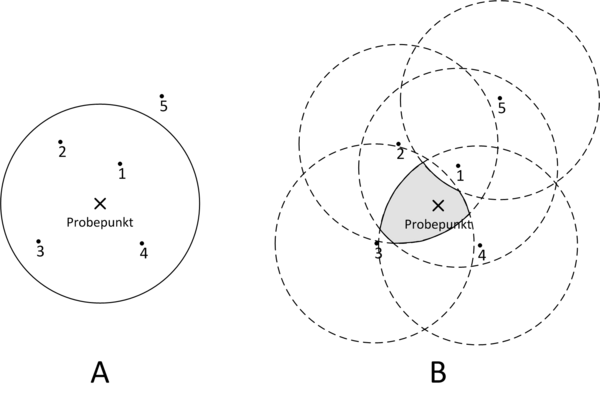Inclusion probability
(→Inclusion zone concept) |
m (→Inclusion zone concept) |
||
| Line 5: | Line 5: | ||
{{info | {{info | ||
| − | |message=Important | + | |message=Important! |
|text=Please always remember that the [[population]] we take samples of, is not the biological population of trees. Sampling in forestry is based on the selection of sample points and not trees. Afterwards an observation is derived by including trees at which we take the measurements (normally this is not only one tree, but e.g. all trees on a plot). Nevertheless we need to know the inclusion probability of each tree to derive an unbiased estimate for the target variable. This probability is the inverse of the [[expansion factor]] that one has to apply if an estimate of the total is targeted. | |text=Please always remember that the [[population]] we take samples of, is not the biological population of trees. Sampling in forestry is based on the selection of sample points and not trees. Afterwards an observation is derived by including trees at which we take the measurements (normally this is not only one tree, but e.g. all trees on a plot). Nevertheless we need to know the inclusion probability of each tree to derive an unbiased estimate for the target variable. This probability is the inverse of the [[expansion factor]] that one has to apply if an estimate of the total is targeted. | ||
}} | }} | ||
Revision as of 20:00, 20 January 2011
In probabilistic sampling each element of the population must have a non-zero probability to be included in a sample, otherwise unbiased estimation is not possible. The inclusion probability \({\pi}_i\,\) refers to the chance that the \(i^{th}\) population element becomes part of a sample. The inclusion probability should be distinguished from the selection probability \(p(s)\) of a sample that is the probability that a certain unordered set of elements is selected as sample.
Inclusion zone concept
Sampling for forest attributes is in some aspects not directly comparable to basic statistical concepts we learn in school. Contrary to basic examples of probabilistic sampling, like the probabilities in a deck of cards or other finite populations, sampling for area related forest attributes take place in an infinite areal sampling frame. As the random selection of samples is based on the selection of dimensionless points in an area of interest, there is an infinite number of possibilities.
 Important!
Important!
- Please always remember that the population we take samples of, is not the biological population of trees. Sampling in forestry is based on the selection of sample points and not trees. Afterwards an observation is derived by including trees at which we take the measurements (normally this is not only one tree, but e.g. all trees on a plot). Nevertheless we need to know the inclusion probability of each tree to derive an unbiased estimate for the target variable. This probability is the inverse of the expansion factor that one has to apply if an estimate of the total is targeted.
To determine the inclusion probability of a single tree, one has to know the relative share of all possible sample point locations that would lead to its inclusion, related to the total area of interest (or one hectare if the values should be reported to this reference). This locus of points is also known as inclusion zone. As the number of points is infinite, the area of this region is used as measure for the probability.
With the below figure this concept is explained for fixed area sample plots. On the left side (A) a sample plot is installed around a selected sample point (cross). Obviously tree 1, 2, 3 and 4 are inside the plot (included). In the right figure (B) the inclusion zones are delineated for all trees (dashed line). In case of fixed area plots they are of same shape and size as the sample plot, but centered at the tree location. For each of these trees, a sample point falling in its inclusion zone, would lead to an inclusion of the respective tree.
The gray shaded area in figure B shows is expression of the selection probability of this special set of trees (all sample points falling inside this area would lead the same set of trees).
| sorry: |
This section is still under construction! This article was last modified on 01/20/2011. If you have comments please use the Discussion page or contribute to the article! |
